Properties
| Storage Buffer | PBS, 50% glycerol, 0.09% sodium azide *Storage buffer may change when conjugated |
| Storage Temperature | -20ºC, Conjugated antibodies should be stored according to the product label |
| Shipping Temperature | Blue Ice or 4ºC |
| Purification | Protein G Purified |
| Clonality | Monoclonal |
| Clone Number | Hi52C |
| Isotype | IgG2a |
| Specificity | Detects ~52kDa. Heavy chain migrates close to FKBP52 on SDS PAGE. |
| Cite This Product | StressMarq Biosciences Cat# SMC-139, RRID: AB_2293934 |
| Certificate of Analysis | 0.5 µg/ml was sufficient for detection of FKBP52 in 20 µg total protein using WB by colorimetric immunoblot analysis using Goat Anti-Mouse IgG:HRP as the secondary. |
Biological Description
| Alternative Names | FK506 binding protein 4 Antibody, FKBP4 Antibody, FKBP59 Antibody, HBI Antibody, HSP56 Antibody, p52 Antibody, p59 Antibody, PPIase Antibody, Rotamase Antibody, T cell FK506 binding protein Antibody |
| Research Areas | Cancer, Cell Signaling, Heat Shock, Nuclear Import/Export, Protein Trafficking |
| Cellular Localization | Cytoplasm, Nucleus |
| Accession Number | NP_002005.1 |
| Gene ID | 2288 |
| Swiss Prot | Q02790 |
| Scientific Background | HSP90 is crucial to cellular signaling by its regulation of the folding, activity, and stability of a wide range of client proteins. These client protein complexes may also contain one or more cochaperones (1). One class of HSP90-binding cochaperone is composed of proteins with a characteristic tetratricopeptide repeat (TPR) domain that forms an HSP90 binding site. Among the TPR cochaperones of HSP90 are Hop/Sti1, protein phosphatase PP5, and members of both the FK506- and cyclosporin A-binding families of immunophilins (2). FK506-binding protein 51 (FKBP51) and FKBP52 are large molecular weight immunophilins that are part of the mature glucocorticoid receptor (GR) heterocomplex (3). The N terminal domain of each protein binds FK506 and has peptidyl-prolyl isomerase (PPIase) activity that converts prolyl peptide bonds within target proteins from cis- to trans- proline. The C-terminal domains contain the TPR repeats involved in protein-protein interactions with the HSP90 (4). Although FKBP52 and FKBP51 share ~75% sequence similarity, they affect hormone binding by glucocorticoid receptor in opposing manners and have different HSP90-binding characteristics (3). FK506 binding protein 51 kDa (FKBP51 or otherwise referred to as FKBP54) has been identified as a progestininducible gene. This protein is predominantly expressed in murine T cells but in humans, it is abundantly expressed in numerous tissues at levels many times higher than FKBP12. The FKBP51 gene is known to be induced by glucocorticoids (5). |
| References |
1. Cheung-Flynn J., Roberts P.J., Riggs D.L., and Smith D.F. (2003) J. Biol. Chem. 278(19): 17388-17394. 2. Davies T.H., Ning Y.N., and Sanchez E.R. (2002) J Biol. Chem. 277 (7): 4597-4600. 3. Wu, B. et al. (2004) Proc. Natl. Acad. Sci. USA. 101(22): 8348-8353. 4. Denny W.B., Prapapanich V., Smith D.F., and Scammell J.G. (2005) Endocrinology 146(7):3194-3201. 5. Cox M.B. et al. (2007) Molecular Endocrinology. Epub. |
Product Images
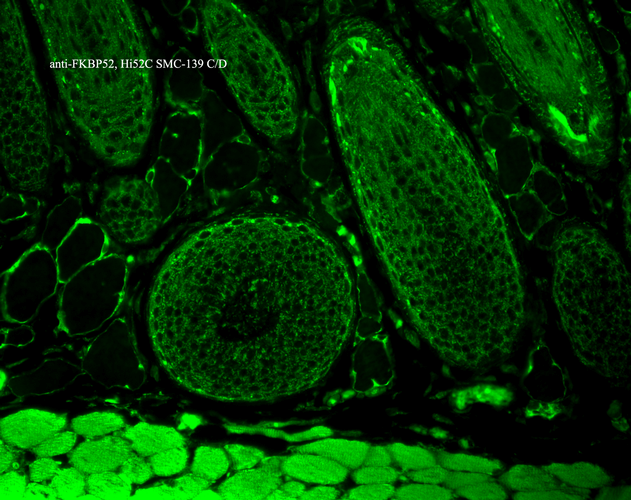
Immunohistochemistry analysis using Mouse Anti-FKBP52 Monoclonal Antibody, Clone Hi52C (SMC-139). Tissue: backskin. Species: Mouse. Fixation: Bouin’s Fixative and paraffin-embedded. Primary Antibody: Mouse Anti-FKBP52 Monoclonal Antibody (SMC-139) at 1:100 for 1 hour at RT. Secondary Antibody: FITC Goat Anti-Mouse (green) at 1:50 for 1 hour at RT. Localization: Epidermis.
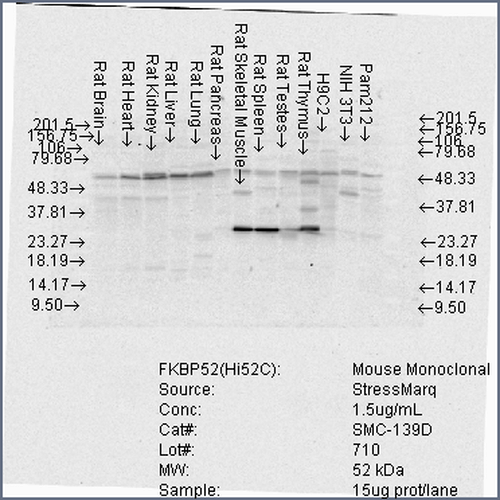
Western Blot analysis of Rat Brain, Heart, Kidney, Liver, Pancreas, Skeletal muscle, Spleen, Testes, Thymus cell lysates showing detection of FKBP52 protein using Mouse Anti-FKBP52 Monoclonal Antibody, Clone Hi52C (SMC-139). Load: 15 µg. Block: 1.5% BSA for 30 minutes at RT. Primary Antibody: Mouse Anti-FKBP52 Monoclonal Antibody (SMC-139) at 1.5 µg/mL for 2 hours at RT. Secondary Antibody: Sheep Anti-Mouse IgG: HRP for 1 hour at RT.
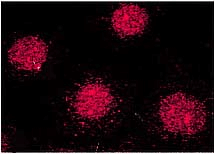
Immunocytochemistry/Immunofluorescence analysis using Mouse Anti-FKBP52 Monoclonal Antibody, Clone Hi52C (SMC-139). Tissue: MCF-7 cells (metastatic mammary gland/breast cell line). Species: Human. Primary Antibody: Mouse Anti-FKBP52 Monoclonal Antibody (SMC-139) at 1:1000. Secondary Antibody: APC Goat Anti-Mouse (red). Courtesy of: Tom Ratajczak, Univ. of W. Australia.
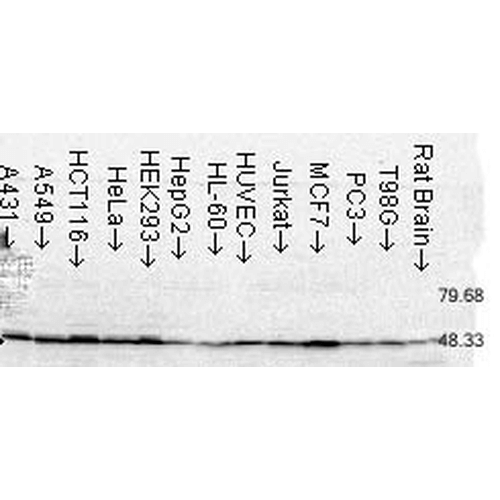
Western Blot analysis of Human Cell lysates showing detection of FKBP52 protein using Mouse Anti-FKBP52 Monoclonal Antibody, Clone Hi52C (SMC-139). Load: 15 µg. Block: 1.5% BSA for 30 minutes at RT. Primary Antibody: Mouse Anti-FKBP52 Monoclonal Antibody (SMC-139) at 1.5 µg/mL for 2 hours at RT. Secondary Antibody: Sheep Anti-Mouse IgG: HRP for 1 hour at RT.

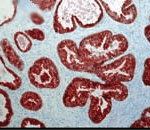
![Mouse Anti-FKBP52 Antibody [Hi52C] used in Immunohistochemistry (IHC) on Mouse backskin (SMC-139)](https://www.stressmarq.com/wp-content/uploads/SMC-139_FKBP52_Antibody_Hi52C_IHC_Mouse_backskin_1-100x100.png)
![Mouse Anti-FKBP52 Antibody [Hi52C] used in Western Blot (WB) on Rat Brain, Heart, Kidney, Liver, Pancreas, Skeletal muscle, Spleen, Testes, Thymus cell lysates (SMC-139)](https://www.stressmarq.com/wp-content/uploads/SMC-139_FKBP52_Antibody_Hi52C_WB_Rat_Brain-Heart-Kidney-Liver-Pancreas-Skeletal-muscle-Spleen-Testes-Thymus-cell-lysates_1-100x100.png)
![Mouse Anti-FKBP52 Antibody [Hi52C] used in Immunocytochemistry/Immunofluorescence (ICC/IF) on Human MCF-7 cells (metastatic mammary gland/breast cell line) (SMC-139)](https://www.stressmarq.com/wp-content/uploads/SMC-139_FKBP52_Antibody_Hi52C_ICC-IF_Human_MCF-7-cells-metastatic-mammary-gland-breast-cell-line_1-100x100.png)
![Mouse Anti-FKBP52 Antibody [Hi52C] used in Western Blot (WB) on Human Cell lysates (SMC-139)](https://www.stressmarq.com/wp-content/uploads/SMC-139_FKBP52_Antibody_Hi52C_WB_Human_Cell-lysates_1-100x100.png)




















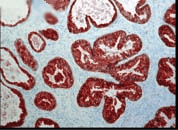
StressMarq Biosciences :
Based on validation through cited publications.